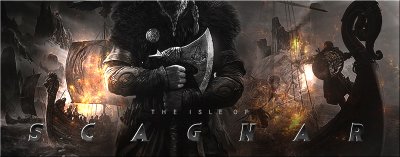Click on an image to change your avatar:
|
 Torvaldlander's Message Board...(torvald)
Torvaldlander's Message Board...(torvald)
I fund this article and posted it on my personal board for reference of such and thought yall might find it interesting as well but wasnt sure where to place it on the new sagas board.... Hope yall enjoy
Did Viking sea monster Hafgufa actually exist
These beings, a mixture of harmful and helpful to humans, have captured the imaginations of countless generations long after the last Viking ship ever sailed and the last skaldic poem was regaled aloud.
It must be worth noting that though these creatures seem mythical to us, these creatures were part of reality for those living in the Viking era.
EzoicIn the early medieval period, the natural world was so unknown, with scientific inquiry a shadow of what it is today.
With so many unanswered questions about the environment and nature, why wouldn't some of the beings featured in the sagas be real?
Following the Viking Age (c. 750 – 1100), many of these creatures became entwined in later Scandinavian folklore and remained part of Scandinavian societies' popular imagination over a millennium after they were first spoken of.
EzoicNow, let's delve into some of the most famous creatures in detail.
Jörmungandr: Giant serpent that encircles the world
One of the most iconic creatures to grace the pages of Norse mythology is the giant world serpent (sometimes also described as a dragon), Jörmungandr.
The result of a union between Loki and the jötunn Angrboda, Jörmungandr, was cast into the ocean by Odin, who disapproved of this union.
As the serpent grew and grew, it reached such colossal proportions that it could encircle the earth, forever biting its tail.
Throughout the Norse sagas, prophecies foretold Jörmungandr's importance during the cataclysmic events of Ragnarök.
During these cataclysmic events, it will emerge from the ocean's depths to engage in a fierce battle with Thor, the Norse God of Thunder.
This takes place long after a previous encounter between the two, where Thor accidentally fished Jormungadr out of the ocean during a fishing trip.
Symbolically, the giant world serpent embodies the chaotic forces that threaten the stability of the cosmos in Norse mythology.
Thor, fulfilling his role as the protector of humankind, among other responsibilities, battles this chaotic serpent, actively contributing to the restoration of stability in the cosmos.
Sleipnir: A noble steed for the All-Father
Only during the 19th century did humans find a means of transport on land – the train – faster than a horse.
For much of the pre-modern age, a horse was a priceless means of transport. As such, horses were revered in a wide variety of civilizations, cultures, and religions, not least for people in Viking societies.
Odin, the mighty All-Father of the Norse gods, possessed a remarkable steed named Sleipnir.
This steed was not only another mythical creature that was the offspring of the Norse God Loki but also possessed eight legs.
Known for its incredible strength and speed, Sleipnir is one of Odin's most trustworthy and reliable animal companions.
It also enabled Odin to traverse the Norse cosmos, easily traveling between the nine different realms that made up the Norse universe.
Fenrir: The giant wolf bound for eternityIt appears that Loki, the Norse god of mischief, was also a bit of a lothario due to the prevalence of his offspring throughout the Norse sagas.
Fenrir, a giant wolf, is one of the three offspring of Loki and the jötunn Angroboda.
The Prose Edda goes into much detail about the sad fate of Fenrir. Due to an act of bravery the Norse god Tyr placed his hand in the mouth of Fenrir.
Now, being a giant wolf, Fenrir did what you would expect and bit it off.
Rather than chastising Tyr for being so foolish, the gods punished Fenrir and bound him with chains until the end of time.In a similar vein to Jörmungandr, Fenrir is also intertwined with the twilight of the gods, the events of Ragnarök.
During the beginning of these apocalyptic events, Fenrir will manage to break free from his chains and battle the Norse god, Thor – who, let us face it, was one busy god during the end of days!
Fenrir also appears in the Heimskringla, whereby a skaldic poet suggests that it is more likely for Fenrir to break his chains than for Norway to have a king as just and beneficial for the kingdom as Haakon the Good.
Huginn and Muninn: All the information in the worldAmong Odin's great qualities was his ability to connect with and befriend creatures from the animal world.
Amongst his most trusted companions and advisors were two ravens: Huginn and Muninn, translated into English as "Thought" and "Memory," respectively.
These birds sit on Odin's shoulders and are sent out every morning to gather information for him and return by the time he begins his breakfast.
Not only were they associated with information and knowledge, but, as people in Viking societies knew after any battle, they were also associated with death.
To kill someone in a battle, a raid, or just in cold blood meant, quite literally, "giving a gift to the ravens."These intelligent and perceptive birds actively contribute to Odin's wisdom and omniscient nature. Without them, he would not be the omnipotent All-Father of Norse mythology.
Interestingly, unlike the Christian God – who is said to be omnipotent by nature – Odin relies on and needs Huginn and Muninn for his great wisdom and knowledge.
This may have contributed to the conversion of some people from the Old Norse religion to Christianity, for the Christian God was presented as even wiser and more prophetic than Odin himself.These mythical creatures of Norse mythology are not merely fantastical entities; they are often symbolic manifestations of cosmic forces, including chaos and divine order.
From the foreboding Jörmungandr and Fenrir, heralds of Ragnarök, to the swift and powerful Sleipnir, to Huginn and Muninn, responsible for Odin's famous wisdom, these creatures contribute to a rich narrative that explores the intricate dance between the Norse gods, mythical entities and we mere mortals.
Together, these creatures form a vibrant and profound mythological landscape that reflects the Norse understanding of their cosmos, environment, and the natural world.
That's a great resource Zea. Thank you for sharing!
WELL DONE ZEE!